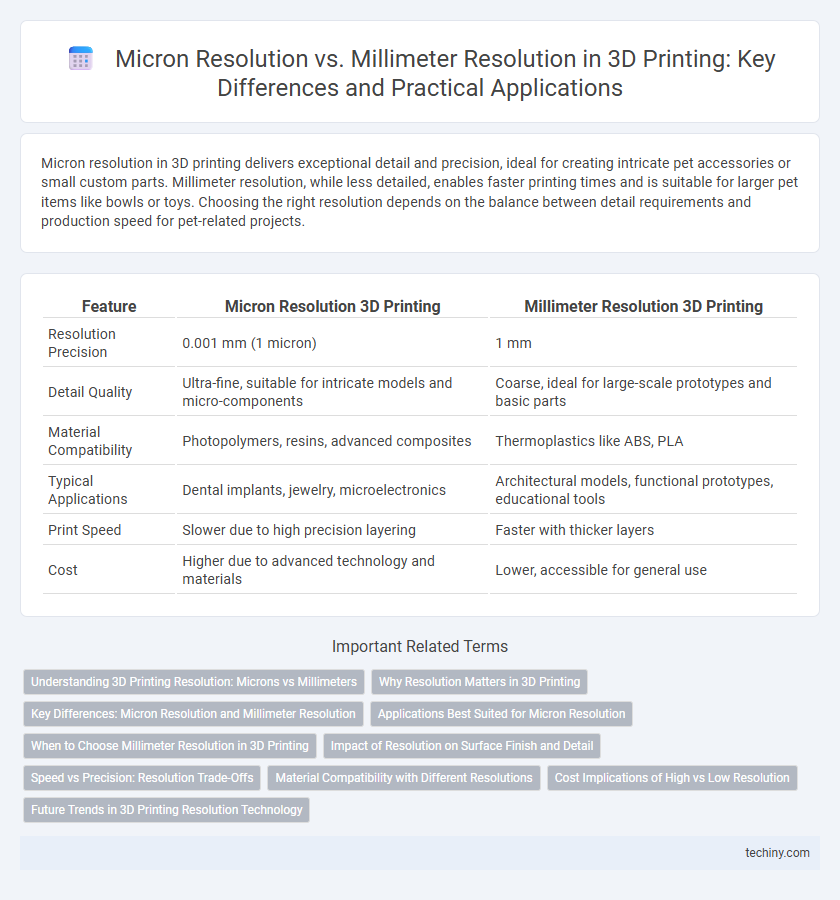Micron resolution in 3D printing delivers exceptional detail and precision, ideal for creating intricate pet accessories or small custom parts. Millimeter resolution, while less detailed, enables faster printing times and is suitable for larger pet items like bowls or toys. Choosing the right resolution depends on the balance between detail requirements and production speed for pet-related projects.
Table of Comparison
| Feature | Micron Resolution 3D Printing | Millimeter Resolution 3D Printing |
|---|---|---|
| Resolution Precision | 0.001 mm (1 micron) | 1 mm |
| Detail Quality | Ultra-fine, suitable for intricate models and micro-components | Coarse, ideal for large-scale prototypes and basic parts |
| Material Compatibility | Photopolymers, resins, advanced composites | Thermoplastics like ABS, PLA |
| Typical Applications | Dental implants, jewelry, microelectronics | Architectural models, functional prototypes, educational tools |
| Print Speed | Slower due to high precision layering | Faster with thicker layers |
| Cost | Higher due to advanced technology and materials | Lower, accessible for general use |
Understanding 3D Printing Resolution: Microns vs Millimeters
3D printing resolution is critical to achieving detailed and accurate prints, with micron resolution offering precision down to one-millionth of a meter, enabling intricate designs and fine surface finishes. Millimeter resolution, measuring in thousandths of a meter, suits larger, less detailed objects where speed and material efficiency are prioritized. Understanding the difference between micron and millimeter resolutions helps in selecting the appropriate printing technology for specific applications, balancing detail, build time, and cost.
Why Resolution Matters in 3D Printing
Micron resolution in 3D printing enables the creation of highly detailed and precise models, essential for applications in medical devices, microelectronics, and intricate prototyping. Millimeter resolution, while faster and suitable for larger, less detailed objects, lacks the fine accuracy required for components with tight tolerances. Resolution directly impacts the surface finish, structural integrity, and functional performance of printed parts, making it a critical factor in selecting the appropriate 3D printing technology and materials.
Key Differences: Micron Resolution and Millimeter Resolution
Micron resolution in 3D printing allows for extremely fine detail, often reaching layer thicknesses as low as 20 microns, ideal for intricate models and precise prototypes. Millimeter resolution features thicker layers, typically ranging from 0.1 to 1 millimeter, suitable for faster prints and larger objects where fine detail is less critical. The key difference lies in precision and surface finish, with micron resolution providing superior smoothness and accuracy, while millimeter resolution offers speed and cost efficiency.
Applications Best Suited for Micron Resolution
Micron resolution 3D printing excels in producing highly detailed and precise parts, making it ideal for applications in aerospace, medical implants, and micro-electromechanical systems (MEMS). This level of resolution enables the fabrication of intricate geometries and fine surface finishes essential for functional prototypes and components requiring exceptional accuracy. Industries demanding microscopic detail, such as dental prosthetics and custom jewelry, also benefit significantly from micron-scale 3D printing capabilities.
When to Choose Millimeter Resolution in 3D Printing
Millimeter resolution in 3D printing is ideal for large-scale prototypes and architectural models where speed and material economy outweigh fine detail. Choosing millimeter resolution reduces print time and cost, making it suitable for functional parts or preliminary designs that don't demand high precision. This resolution caters to applications in construction, automotive prototyping, and industrial manufacturing where robustness and scale are prioritized over intricate detail.
Impact of Resolution on Surface Finish and Detail
Micron resolution in 3D printing enables ultra-fine surface finishes with intricate detail, capturing complex geometries and textures that millimeter resolution cannot achieve. The smaller layer thickness at micron scale reduces visible layer lines, resulting in smoother parts suitable for high-precision applications like dental prosthetics and microfluidics. Millimeter resolution, while faster and more cost-effective, produces rougher surfaces and less defined features, limiting its effectiveness for detailed prototypes or functional components requiring accuracy.
Speed vs Precision: Resolution Trade-Offs
Micron resolution in 3D printing delivers exceptional precision by enabling layer heights as fine as 1-10 microns, ideal for detailed prototypes and intricate designs. Millimeter resolution offers faster print speeds with layer heights typically around 0.1-1 millimeter, suitable for large-scale models where time efficiency trumps fine detail. The trade-off between speed and precision hinges on the application requirements, with micron resolution favoring accuracy at the cost of longer print times and millimeter resolution prioritizing rapid output with reduced detail fidelity.
Material Compatibility with Different Resolutions
Micron resolution 3D printing supports highly detailed structures ideal for biocompatible polymers and photopolymers used in medical and dental applications, whereas millimeter resolution is better suited for robust thermoplastics like ABS and PLA, commonly used in prototyping and industrial parts. Materials processed at micron scale require precise control of curing or extrusion parameters to maintain accuracy, which limits the material types compared to millimeter-scale printing that offers broader compatibility with composite filaments and high-strength plastics. Understanding the interplay between resolution and material compatibility is critical for selecting the appropriate 3D printing technology tailored to specific functional and mechanical requirements.
Cost Implications of High vs Low Resolution
High-resolution 3D printing with micron-level precision demands advanced hardware and specialized materials, significantly increasing production costs compared to millimeter resolution printing. Lower resolution printing reduces expenses by using standard components and faster print speeds but sacrifices detail and surface finish, impacting the quality of intricate designs. Cost-efficiency in 3D printing is therefore directly influenced by the chosen resolution, balancing precision needs against budget constraints.
Future Trends in 3D Printing Resolution Technology
Emerging 3D printing technologies are advancing toward achieving micron-level resolution, enabling the fabrication of intricate microstructures with unprecedented precision compared to traditional millimeter-scale printing. Innovations in photoresins, laser optics, and multi-photon polymerization are driving resolutions below one micron, enhancing applications in bioprinting, microfluidics, and electronics. Future trends indicate a convergence of nanoscale resolution capabilities with scalable manufacturing, promising revolutionized product complexity and miniaturization across industries.
Micron Resolution vs Millimeter Resolution Infographic

 techiny.com
techiny.com